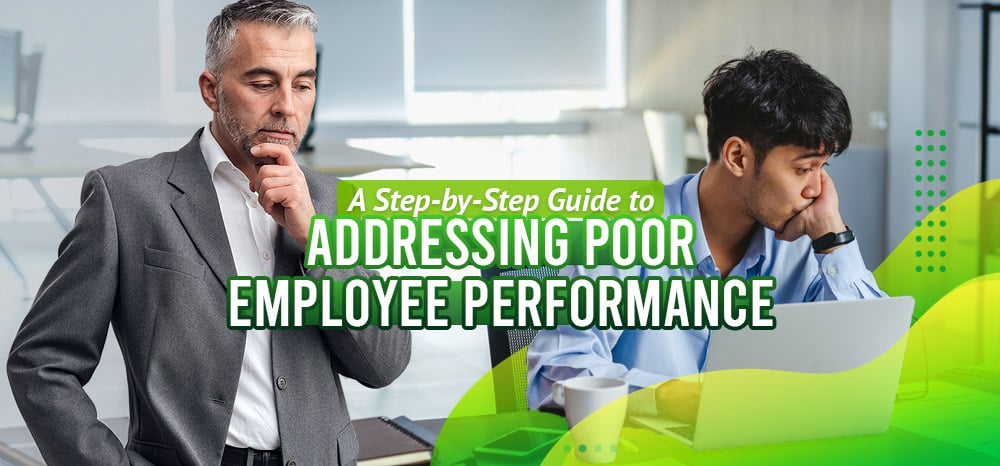Being a leader is empowering, but it’s also a huge responsibility. And one of the most unpleasant tasks that come with the job is addressing your subordinates’ poor work performance.
Whether you’ve been running your own company for the last 25 years or have just started a year ago, dealing with underperforming employees will always be a touchy subject. Not only does it require dealing with people’s emotions, but it will almost always put your leadership to the test.
But while there are no hard and fast rules for situations like these, there are guidelines that may help:
Defining Poor Work Performance

Before we address the issue, let’s talk about what counts as poor work performance to begin with.
Most of the time, we think of inadequately carrying out job tasks and responsibilities. However, poor performance can also refer to an employee’s behavior within the team.
So, even if an employee performs fairly well on the job, we can still consider them problematic if they don’t seem to treat their colleagues with respect.
Understanding the Most Common Causes
To address a problem effectively, we need to identify the root cause first. Typically, these can involve:
Your Employee Isn’t Properly Equipped

Does your staff have the right tools, instructions, or training? If not, that’s likely why they can’t deliver quality results.
In this case, identify what is lacking and fill in the gap accordingly.
Workplace Disengagement

We all have off days at work. However, if your employee is constantly underperforming, there could be an underlying issue. Perhaps it’s because they feel a lack of involvement in decision making. Or worse, a lack of appreciation for their efforts.
If this is the case, you could try and involve your team members more during the planning stages. And of course, don’t forget to recognise their contributions too.
External Factors

Sometimes, the problem isn’t with your company policies or team members. Try as we might to leave personal problems at the door, such external factors can and will affect work performance. We aren’t robots, after all.
Unfortunately, there isn’t much you can do in this case, though conveying empathy always helps. You don’t have to counsel the said employee, but you can offer options for them to give them a bit more flexibility as they try to resolve what they’re going through. Think encouraging them to take time off, offering a hybrid work arrangement, etc.
Addressing the Problem Head-On
Address problems related to poor work performance right away. Don’t wait for the scheduled performance review if you can talk to them the next day.
Here’s what you should do before, during, and after talking to the employee in question:
Before

Before scheduling a meeting, think about the possible factors behind their poor work performance first. (Check the previous section.)
Once you’ve got a rough idea of how you’d like to conduct the discussion, inform your employee that you’d like to have a chat. Better if you can do this before or after the work day so there aren’t a lot of distractions.
During

Go in with the intention to listen and understand. If they’re not really talkative, start by asking about how they’ve been feeling at work lately.
Then talk about the purpose behind your meeting and be specific and concrete. This applies to your observations, feedback, and constructive criticisms related to their work performance.
Talk about how you can work together and help them perform better.
After

Thank your employee for being open and honest about his/her struggles. Better yet, write them an email the next day reminding them of the key points and your plan of action. More importantly, follow through with follow-ups and conduct performance reviews as needed.
Struggling how to address performance problems in a remote setting? You’ve come to the right place!
Remote Staff has been assisting more than 3,000 Australian SMEs and entrepreneurs for the last 15 years and counting. Aside from helping them hire skilled remote workers from the Philippines, we also assist with onboarding them for a hassle-free transition to a remote setting.
Call us today or schedule a call back and let’s start building your team.
Serena has been working remotely and writing content for the better part of the last decade. To date, she's written for Pepper.ph and Mabuhay Magazine, among others, and has churned out more than a thousand articles on everything from The Basics of Stock Market Investing to How to Make Milk Tea-Flavored Taho at home. Hermits, aspiring hermits, and non-hermits with interesting project propositions may email her at serena.estrella10@gmail.com.
























 Zero Recruitment Fee
Zero Recruitment Fee